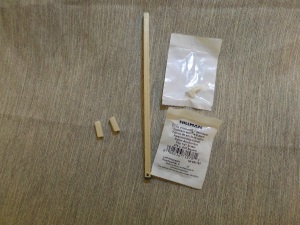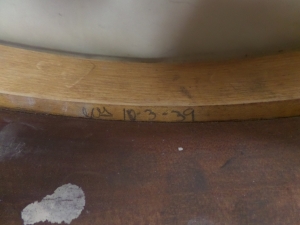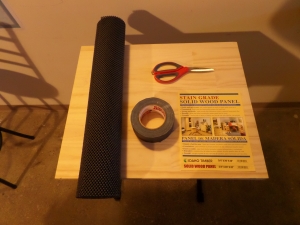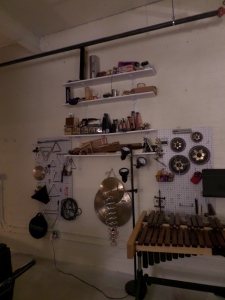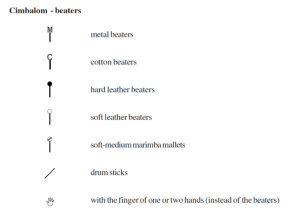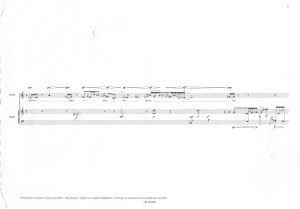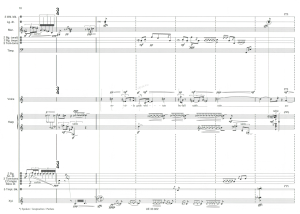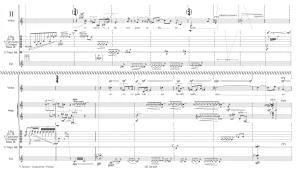Milton Babbitt was gracious enough to grant me an interview at Tanglewood in 2006. I conducted the interview in support of a research paper I was working on at the time whose theme now eludes me. Since I transcribed this text from an audio recording, any errors in grammar or syntax are mine and not Babbitt’s (please let me know if you notice any mistakes!). He gave me explicit permission to share the contents of the interview, and with his signature wit, encouraged me to try to make money off of it. No paywalls here though. Enjoy!
(I highly recommend watching the documentary “Babbitt: Portrait of a Serial Composer“. I love the reference in the title. I hope it was Babbitt’s idea.)
August 6th, 2006, Lenox, Massachusetts, USA.
Nicholas Tolle: “For if the formal conditioning of potential and eventual musicians and their audience demands informed guidance and the informal conditioning presumes the constant presence of informed performance, the former has long been and is increasingly threatened by the conditions of music education.” (Milton Babbitt: “Collected Essays; Brave New Worlds” page 461) What do you mean by informal conditioning?
Milton Babbitt: That is the conditioning that you acquire from the moment you’re born; with all the music you hear, the music you’re subjected to, with all the discourse you hear on television and radio, very often incorrect or sometimes just naïve. For example, the music you’ve picked up since you were born without any say over it is totally different from the music I picked up. I mean, I know a thousand pop songs from between 1920 and 1935. You probably know one or two of them at the most. Have you ever played pop or jazz?
NT: Yes
MB: Well then you might know a couple of them because they became what they call “standards.” This has certainly conditioned me. I can’t possibly define how it’s conditioned me, by its very nature I can’t define it because it’s having an effect on me that I’m unaware of when I sit down to make a composition.
NT: What is it about this informal conditioning that assumes the constant presence of informed performance?
MB: By informed performance I mean exactly what you’re seeking. That is performance which, presumably, starts from some conception of the total piece. I mean, for example: when some conductors start, let’s say, the Fifth Symphony of Beethoven, some will be aware of the fact that the Eb to F in that opening motif will return as the Eb to F of that so-called second theme and that there will be this continuity, this connection, featuring the so-called first theme and the second theme, whatever you call it; first collection, first so forth. How he thinks about the rest of the piece will reign through a different light depending on how he thinks on that very first Eb to F which occurs in the first couple of measures. And that will certainly affect his performance and choices he makes with regard to dynamics and everything else which the listener will hear very easily.
NT: What is it, aside from the decline of availability of music education, that threatens informed performance?
MB: Well, first of all, you’ve got to mean the availability of music education which (and I don’t know today, I haven’t seen the latest books) reached a point of sophistication about twenty years ago when some people were writing books called Elementary Music Education which reflected a knowledge much beyond that and a very sophisticated knowledge of contemporary analysis, and therefore an attempt to reflect a little of that in the most elementary music education. That seems to have disappeared. The books are no longer even being published. You can’t publish a book called “An Elementary Course in Music Education.” No, let’s forget music education, “An Elementary Course in Introduction to Music.” They used to be very sellable and very profitable. Well, they’re not anymore. They’ve stopped being written, they’ve stopped being published, and they’ve been allowed to go out of print. Courses of that kind used to attract three hundred or five hundred students at a good university. They either don’t exist or they attract a very small group of students. Where did you go to school?
NT: I went to the Boston Conservatory.
MB: See, that doesn’t count. I am talking mainly about universities. Most of the conservatories have no introduction or appreciation of music courses because it is assumed that the students will be able to read music, and heaven knows how they do it, who gets these kids to music these days, but that is a different story. The conservatories are yet a different problem because very often, the students are never made aware of those, if you wish, verbal methodological considerations which precede the very possibility of what we consider discourse about music or anything else. In the universities, some students will be, I don’t want to say subjected to that, but will be aware of that and concern themselves about it. Not necessarily but often they will. If you give a course in so-called “theory,” at a first-rate university, and you are bound to have some students who say “You call that a theory? It’s not a theory.” I mean, in Princeton they’ll say, “We’ve taken a course in theory construction with Carl Hempel and this isn’t a theory at all. At best, this is a series of observations or a few general cases.”
NT: What sociological changes have brought about this change in the last twenty years?
MB: Well, I’m not a sociologist and I really can’t answer that in any definitive way. It probably has something to do with the fact that the masses have taken over. There has never been a pop music that took over and dominated our culture the way that rock, and now what’s followed rock, hip-hop, or whatever it is, has. There has never been anything like that. Never before. And now that is certainly what is regarded as the popular music. I was saying something earlier to a group of composers about the fact that you can’t go out on the streets of New York anymore at night, and, night after night, learn the complete literature of piano music, for example. And one of the students didn’t think that it was of any importance because you can go out and go to four or five joints in the village and hear a few rock groups. That is the fundamental change. You can’t hear the music anymore. Where are you from originally?
NT: St. Louis.
MB: Well, I don’t know anything about St. Louis and I wouldn’t dare talk about St. Louis, but in New York, where I went to in order to be able to hear all this music, the transformation is such that the halls themselves have disappeared. There is no place where you can play this music. So that, if the music isn’t available, people are not going to hear it, and people who are seeking it become discouraged. The works that were heard constantly on the stool during the season are not being played at all. Halls like Town Hall which used to have at least one concert a day and four or five over the weekend don’t have concerts at all anymore. Times Hall has become a radio station, and so on and so forth. And, for example, people are not even aware of the music because the newspapers, which were never exactly the….well I should be careful about this while serving the province of sophisticated discourse about music. Nevertheless, you could get information. You could find out about what happened last night. You can’t find out what happened last night anymore because they don’t do it the next day. You don’t even know when a review will appear. And you’re not interested in the review because of the normative aspect, but to find out what happened so to speak. They don’t cover most of that anymore.
NT: It’s funny you mentioned that, because the New York Times review of the “Soldier’s Tale” performance (note: Babbitt had recently played the part of the devil in a performance of Stravinsky’s “The Soldier’s Tale” at Tanglewood) just last week still accused you of writing an article called “Who Cares If You Listen?”
MB: Of course. Well there used to be six or seven people covering these. Some of them would come with scores and so on. A great many of those people have gone. The only thing I can say about it is how are we going to get reasonable information forgetting the judgmental aspect of it? If people don’t know it has been happening or is happening, and if its taken over by even worse public radio where the people are completely uninformed and pretentious. They’ll tell you what is important and isn’t. Our little singer over here (note: Babbitt is referring here to Jo Ellen Miller, who performed in Babbitt’s 90th birthday concert at Tanglewood on the day of this interview), whom you know, and who will be singing my music tonight; she’s new to this part of it. She comes from Michigan, and she was terrified to be interviewed yesterday by public television, a couple of wise guys, and no matter what she said they would disregard it because they didn’t know who these people were that she was talking about, and they had their own questions such as “What roles would you like eventually to sing?”… these generalized questions which had nothing to do with her specifically and didn’t represent anything that would define her as a musician or as a person. I hate to be an enemy of public television but they have these pretentious… I don’t whether you have them or not. Maybe Boston is a little better, because public television is not the same everywhere. But they have these people that presume to tell you what is beautiful, what is powerful, what is important, and then they’ll always tell you what they like best. The problem is one of public communication. Forgive me. We are off the track, but really we aren’t off the track at all. I mean, what are you going to do when you are through with school? How do you make a living? You either have to abandon this, or find some support. Where is the support going to come from?
NT: Like my colleagues, and your colleagues I am sure, teaching will be a big part of it.
MB: Exactly, well that’s it. That is why when one writes that the university is virtually the only hope for a composer, one is talking in very practical terms. Who has not taught at a university? Even an extremely wealthy composers like Elliott Carter, nevertheless, has taught at a university, if you call Yale a university. He’s taught at a number of places, Columbia for example, where he was let go because Frank Wigglesworth was returning from Italy. I put that in as a bit of academic, what shall I say, not gossip, but academic fact which might startle a few people. Look, Elliott taught a little bit because he wanted to be in contact. He didn’t have to, but he thought teaching at a university was a good idea for a composer. He’s one of the few composers who’s strongly supported by his own devices. His own devices being what he inherited. There are few composers like that, but not many. What composer do we know, no matter how successful by public or private criteria, is not teaching at school or has not taught in a school? I’d be hard pressed to think of one. People think that Aaron Copland didn’t teach. Aaron Copland too had private money, but Aaron Copland taught.
NT: You once said that “Communal commonplaces, rather than singular discriminants, become the constituents and ultimates of the vocabulary of analysis.” How does that vocabulary compare to the vocabulary that is used to teach analysis to music students?
MB: I didn’t want to go too deeply in to that. The communal aspects of that of course, as you know perfectly well, refer to pieces as beautiful. We can get very technical about this, about the fact that “beautiful” is a supervenient and these are unexplicated supervenients and there is simply no way of finding out what these words mean in that vocabulary. If they don’t explicate the supervenient, we’re stuck. Or it can be nothing other than something of which they will never admit is some incorrigible statement of personal disposition. They will never say, well very few of them except Virgil Thomson, will say “I like it and that’s the end of it.” Even he didn’t say “I like it and therefore it’s a great work.” He would come close to it sometimes. But he sort of reveled in his irresponsibility, I mean, he was a clever guy. But look: there have been serious critics, and there have been critics who tried to deal with the public aspect of criticism, and use a language that was responsible and explicable. For example, Benjamin Boretz. Benjamin Boretz, when he was a critic for The Nation, which was a political magazine, but nevertheless for the general reader, the general political reader, he managed to do it. And I want to say that that points out something else: there was a time when The Nation and The New Republic and The New Yorker, which was very different from what it is now, all had music critics who wrote in that magazine every week. That’s gone except the New Yorker. The general readers aren’t even aware of the fact that people are writing about these things. The records are occurring less and less of course that there is any contemporary musical activity going on.
NT: In your essays, you say a lot about program notes, positive and negative. In your experience, is your work received more enthusiastically if it preceded by some sort discussion or pre-concert talk?
MB: Yes, it is. It usually is. Enthusiastically may be an exaggeration. But more calmly, and with more acceptance. For two reasons: now we are talking about when I appear in person and talk in advance. Because they realize I take seriously something they weren’t prepared to take seriously. Either they think it’s a hoax or something totally meaningless. Just consider the difference, and this is something that came many years ago that at your age you would have been unaware of, of the question of so-called abstract painting. That’s when Clem Greenberg, who was a very sophisticated critic (we had nothing comparable in public music), used the expression “autotelic,” by which he meant that it didn’t represent a reference to any object in the world outside of the canvas. I would use the word automorphic with regards to our wholly context-dependant music. But think of the difference of those two fields from that point of view. When someone sees a painting that seems totally, absolutely without any reference, they always say “what is that supposed to represent? A tree? A bird? Superman?” When they hear a piece of music, what do they say? They say “you call that music?” By which they mean referenced to other music. It’s important because they compare music with regard to familiar music; they compare paining with regard to references outside the paining, and that makes a great deal of difference because that brings us back to the point that it will be much more difficult for them to regard the music with any degree of serenity and coherence.
NT: Is it important to you that a musician performing your work understands the musical language on which it is based?
MB: We won’t quibble at the moment with understanding. That’s a toughie. That is very hard to come to terms with. But let me say that…I’m gonna be careful about this. The best performers I’ve ever had to deal with certainly have tried to approach the generalities of the musical language and the specifics of a particular work. The answer is yes. But to what extent, that’s very hard to define. I am not sure I can. The point of understanding a work… you’ve slipped in a toughie there. Did I write that?
NT: No.
MB: Good. Thank god. Because what does it mean to understand a piece of music? But, I have many examples of where performers who thought they understood what I was doing had misunderstood it so violently that they played the piece… I won’t tell you who the performer was, but it was a very well known violinist… they looked at my pencil writings. That is my original manuscript. I always write with a pencil in a notebook. They saw these numbers, 3 and 4, 2 and 4, and so forth, and thought that it was the secret that was behind work, because they think numbers, 12-tone and so forth. Well, it’s shorthand that I use no matter what the piece. If I put 2 of 3 it means the second note of a triplet. That’s all it means. And he began to unravel what he thought was the secret of the work. And he played the piece very badly in terms of a kind of conception that had nothing to do with the piece. That’s an extreme example of course. Mainly I find that the best thing is a performer comes along, who plays the piece and then begins to get curious about it, and then begins to make his own analysis. He may come up with things that are a bit deviant from what I thought, but that doesn’t mean I’ve always thought of the best possible way. I just think generally that experienced, intelligent performers will get in to the piece, and then we’ll work on it together. I’ve heard many performers play Beethoven’s Opus 111 who had never gone through the Schenker analysis of it but it would have helped them if they had.
NT: We kind of take it for granted that musicians performing tonal music have a working knowledge of tonal music theory.
MB: Oh, no!
NT: Well, to some extent, at least more so than contemporary music.
MB: That’s true.
NT: I am wondering to what extent should performers of contemporary music concern themselves with the theory behind it.
MB: Well, I can’t think it would hurt, because we have extraordinary examples of contemporary theory as I know and you know. We have a sophistication of contemporary theory now that is so considerable that how can you read it all? I can’t possibly read all the articles I would like to read forgetting all the other ones out there that I am not sure I’d care to look at. I mean you have at least a half dozen publications in this country which are loaded with relevant articles in every issue, and you can’t read them all. You pick out what you think will be most valuable to you. I think of six publications which I would assume that any musician would find something in, and there are more than that when you consider that there is one magazine in England. That’s as far as you can go across the ocean. It’s called Music Analysis. Quite characteristically it is very expensive, but it is a very good analytical magazine. It’s the only one over there, and the English one is very close to the American model. But there are differences and it’s a very interesting magazine. But there is nothing in any of the others. You find the other extreme: you find the quasi-mathematical, the quasi-technological, or who knows what. Getting back to the question again, of course, I’ve always found that the performer, and I know a few of them, who read some of these articles, and have questions about them, and question me as they are learning a piece of mine, yes, of course it’s better. They make decisions about certain ways of playing certain passages that they would not have made if they hadn’t read them. So I mean obviously to read analyses about a piece is to acquire knowledge about a piece that you may decide is useful to you, or not. When you don’t have that alternative, you may stumble through the piece. People have stumbled through my pieces.

